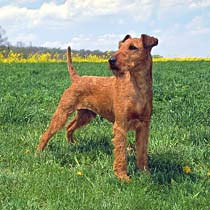|
The Canine Chronicles Directory
Irish Terrier

The Irish Terrier has a weather resistant, double coat. The outercoat is course
and wiry and the undercoat is soft and fine. The coat colors are generally red,
red/wheaten or yellow/wheaten. When showing this breed, a small amount of white
is allowed on the chest. There should not be black shading on the coat nor white
markings on the feet. The long head should be narrow between the ears and have a
slight stop. The skull should be flat and the muzzle bearded. They should also have
profuse eyebrows. The prominent eyes should be small and the small, v-shaped ears
fold forward. The jaw should be strong, the lips and nose black and the teeth meeting
in a level or scissor-like bite. The long neck slowly widen towards the well laid
back shoulders. The chest is deep and the body moderately long. The back is straight
and well-developed. The strong, well-boned forelegs should be perfectly straight.
The straight muscular hindlegs should have well let down hocks and fairly bent stifles.
The hair on the hindlegs should be dense and brusque. The round feet should have
arched toes with black toe nails. The high set tail is customarily docked to three
quarters.
|
|
Temperament
|
Irish Terriers are animated, courageous, hot-tempered, reckless and feisty. Due
to this, they have earned the nickname 'The Daredevil'. They are great with children
and love to play hard. They are devoted and affectionate towards their family. They
are very friendly with people; however, they have strong protective instincts. They
can also be aggressive toward other dogs. Due to this, they should be socialized
thoroughly from an early age. They should not be trusted around non-canine pets.
|
|
Height, Weight
|
Height: 18" ; Weight: 25-27 lbs.
|
|
Health Problems
|
The Irish Terrier is a hardy breed and not prone to many health problems.
|
|
Living Conditions
|
The Irish Terrier will do okay in an apartment if it is sufficiently exercised.
They do best with a medium-sized yard. If they get enough exercise, they are well-mannered
and more dignified indoors.
|
|
Exercise
|
Irish Terriers have lots of energy and need lots of regular exercise. Hold on tight
to its lead as they can be dog aggressive.
|
|
Life Expectancy
|
About 12-15 years
|
|
Grooming
|
The Irish Terrier only needs to be brushed occasionally to prevent matting in its
coat. Remove dead hair with a fine comb. Bathe only when necessary. This breed rarely
sheds.
|
|
Origin
|
The Irish Terrier originated from County Cork in southern Ireland. They are thought
to be the oldest terrier breed dating back to over 2000 years ago. However, the
earliest images of this breed were found in paintings of the 1700s. It is thought
that they possibly descended from old black and tan terriers and wheaten terriers.
They were used as exterminators of den animals, such as the otter and water rats.
This breed became very popular in England in the late 1800s. The United States Irish
Terrier breed club was started in 1896. Irish Terriers were used as messenger dogs
during World War I, attributing to their fearless reputation. They are recognized
by the AKC and the UKC.
|
|
Group
|
AKC and UKC Terrier
|